“There is no symbolism for the “disappeared”. They were taken away without a trace. That was part of the terror tactic: the permanent anguish it caused the family. It is described like living with a ghost; they are not dead, but they are not alive either. The idea that some day they might return (although highly unlikely) does not allow for them to be dead. Keeping them alive and constantly present in mind does not allow for the survivors (the family) to continue living. One cannot mourn for a person who might possibly still be alive; how to move forward while maintaining the memory alive? Unlike the victims of the Holocaust, there are no monuments, no symbol (like the yellow star, the pink triangle); the “disappeared” have no meaning. They are referred to by their state of being, by a verb that was never active until now (someone is “disappeared” by someone else).”
– Analia Penchaszadeh, Youth Sourcebook on Sustainable Development
Buenos Aires – It’s been a noisy week here in town. Monday, extending an already long Easter weekend, started us off with the Día Nacional de la Memoria por la Verdad y la Justicia, or national day of memory for truth and justice – in commemoration of the military coup on March 24, 1976 that overthrew the government of Isabel Perón and added a whole new level of terror to living in Argentina at the time – disappearance. From 1976 until 1983, when democratically elected civilian rule was re-instituted a huge number of people, primarily those of left-wing politics, simply vanished – soldiers or police showed up at homes and dragged one or more family members away, children went out to play or to school and never returned – official estimates range from 9-11,000, while most human rights activist groups put the numbers at around 30,000.
A few of the children, now grown, have been found, mass gravesites have been uncovered, evidence of large numbers of people simply shoved from the side of military planes out over the ocean has come to light… and for years, the elected governments simply asked the population to “forgive and forget”. Only in recent years has there been an official push to both uncover the truth and prosecute those responsible. But, the people have been pushing for 20+ years – with the weekly “mothers” march at Plaza de Mayo that has become, for most visitors, simply an odd tourist attraction, to the annual march and rally that includes everything from music to political speeches to reading lists of names of the disappeared for hours on end. Like many marches, this one has, unfortunately, lost some focus – while the vast majority of people were clearly there with the spirit of the day in mind, there were also political groups simply there to push their own political agenda – a shame, as it dilutes the message of the day – I spent a couple of hours in the plaza, and chatting with various people it became clear that many had no idea what the event was about – it was just a day to get out and “protest against the government” for unspecified reasons.
The week continued with three evenings of cacerolazos – pot bangers – not a unique form of protest to Argentina, but one raised to an art form. Basically, people take to the streets, their balconies, their yards, banging on pots (cacerolas, or casseroles, which is where the name comes from) in a vaguely rhythmic pattern that goes on for hours, waxing and waning, but spreading throughout the city. This one centered on Recoleta, our neighborhood, where many of the owners of campos – the big farms – live. But it quickly became citywide, and even on to other cities as people heard about it – roughly from 8 to 10 p.m. each night, Tuesday through Thursday.
I can’t remotely do justice to the complexity of the situation, and, of course, there are two sides to this fight, like most. However, the nutshell version – the ranchers and farmers claim is that after the crash in 2001 they became the backbone of the country, keeping up the food supply at reasonable costs, and that the government has steadily increased taxes on them – both on their land and their products, and that the latest, and final straw, was a recently iincrease from 35% to 44% on export taxes that has been imposed as an effort to make exportation completely unattractive and keep domestic products in country.
The problem, from their view, beyond the outrageous amount, is that the tax is imposed on products, like soy, for which there is no domestic market (Argentina is the second largest producer of soy in the world, virtually all of it exported for cattle feed in North America and Europe) – not to mention it was imposed in the middle of the harvest season, long after everyone was committed to what they were growing and selling. So the ranchers and farmers have simply stopped shipping a large quantity of stuff – beef being the most noticeable – to the capital – tourists arriving are finding none of the legendary beef awaiting, and locals are trying to figure out what to do with a whole lot of chicken and fish that they’re not used to eating on a daily basis.
From the government side, if I’ve got this at all correct, the feeling is that the ranchers and farmers did this to themselves, by seeking more profitable export markets at the expense of producing for domestic consumption. They claim that the whole soy thing was a bunch of farmers trying to get rich quick rather than supply food to a hungry nation, that the soy (much of it genetically modified) is destroying the soil, and that they’re trying to force the farmers to replant crops that will be of use to feed the tens of thousands of people in the country who are starving. On the beef side, prices controls have been in effect for years, which is a way of keeping the national meat affordable for those who are poor, and, of course, if the controls are lifted and/or the high export taxes lifted, beef will simply become unavailable for a large portion of the population. Obviously, both sides of this are more complicated than these few sentences, and asking any individual Argentine seems to elicit a different answer as to exactly what’s going on, why, and what should be done about it. Time will tell.
I’ll leave with a series of photos from the Monday rally and march…
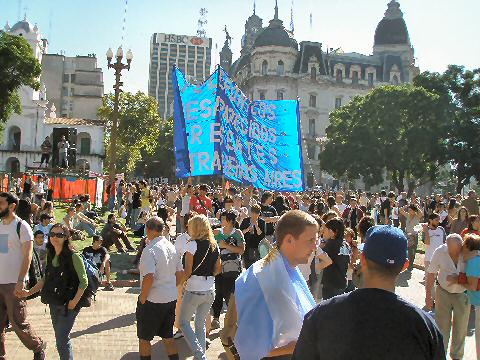
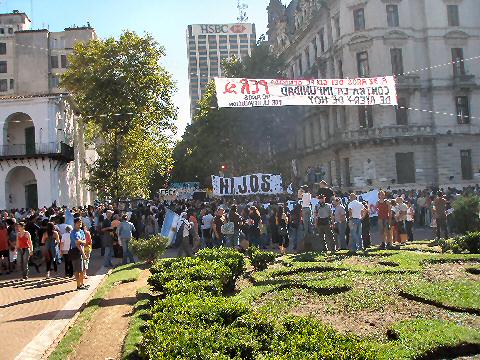
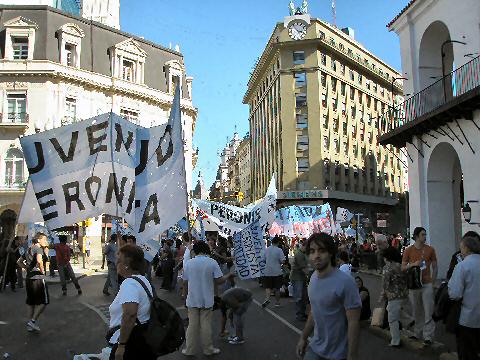
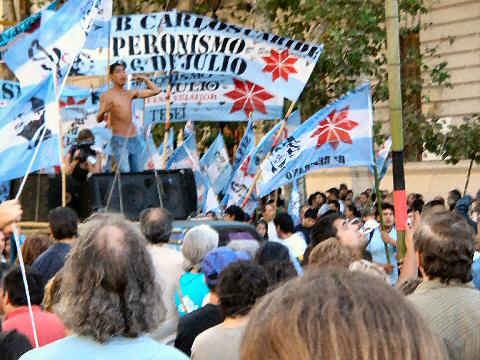
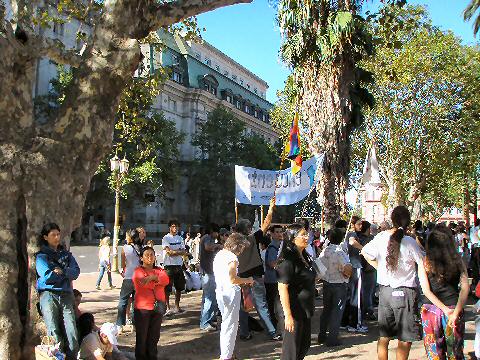
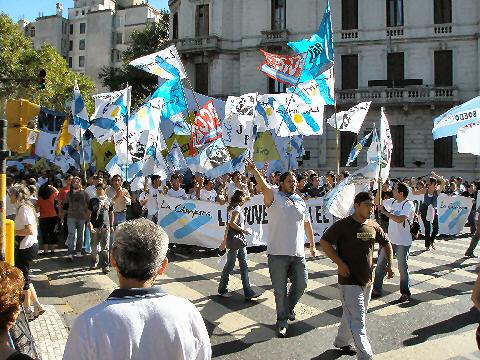
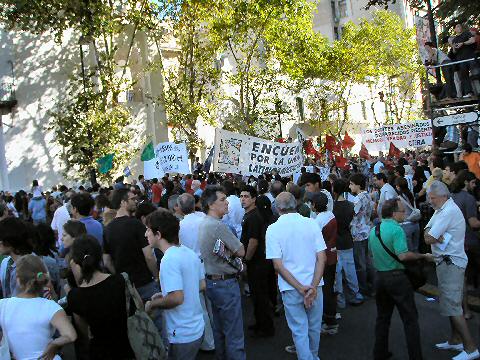
Of course, even at a memorial march and rally, someone has to try to make a quick buck…
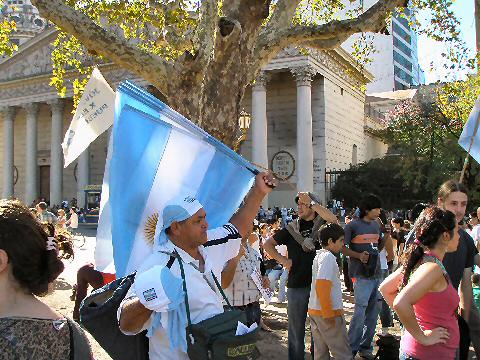
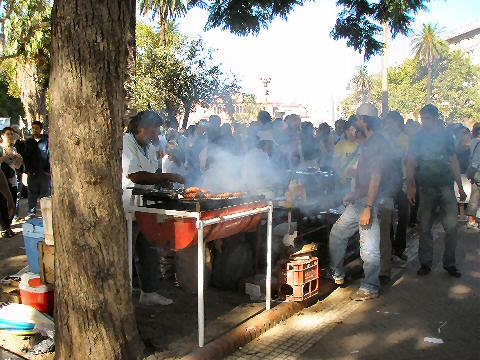
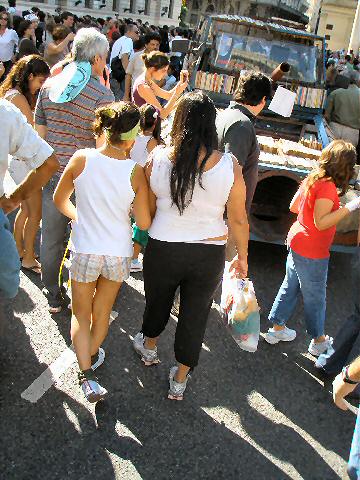
[…] Aires – In my post the other day I talked a bit about the back and forth battle between the Argentine government and […]
[…] is three deep with people at the meat, i.e., beef, counter. With the 30-day suspension of the strike, people are battling over the packages of red meat like they’re stocking up for an impending […]
[…] of the populace, he may not get that acquiescence this time around. There have been almost nightly cacerolazos, as people take to their balconies and sidewalks to express their displeasure at the continued […]
[…] of the populace, he may not get that acquiescence this time around. There have been almost nightly cacerolazos, as people take to their balconies and sidewalks to express their displeasure at the continued […]